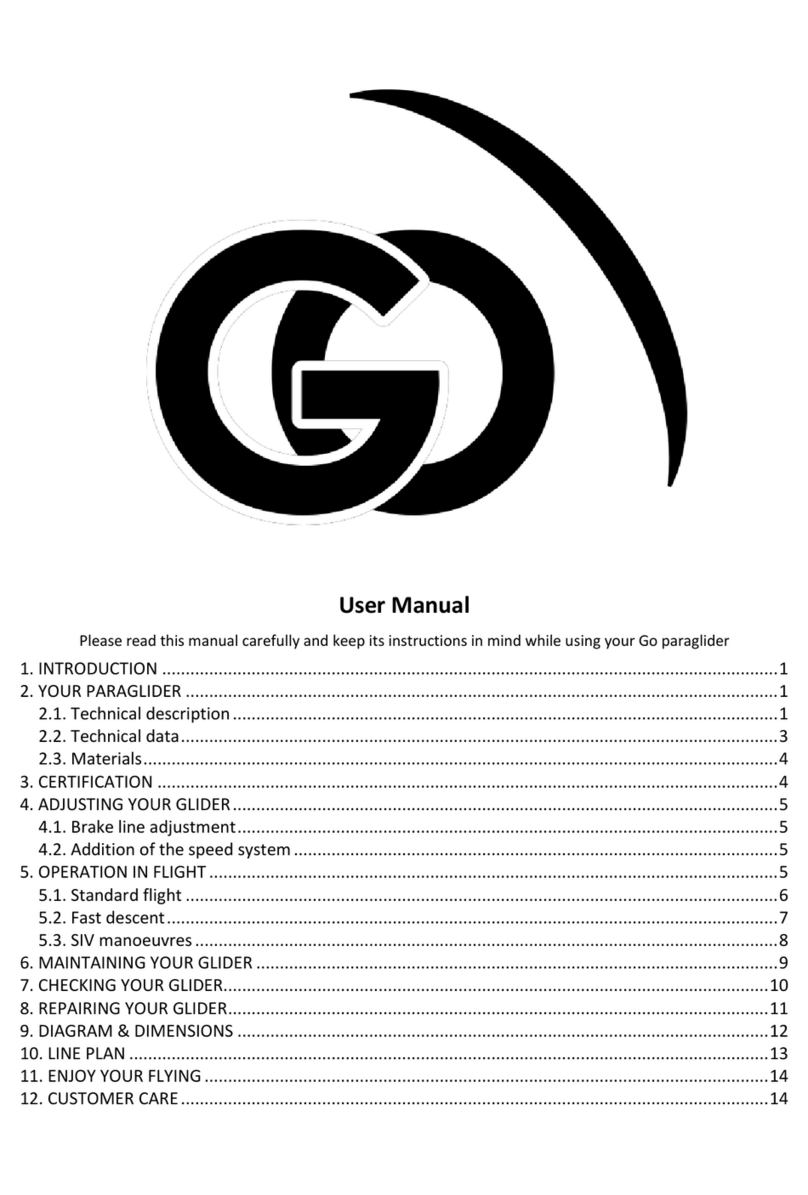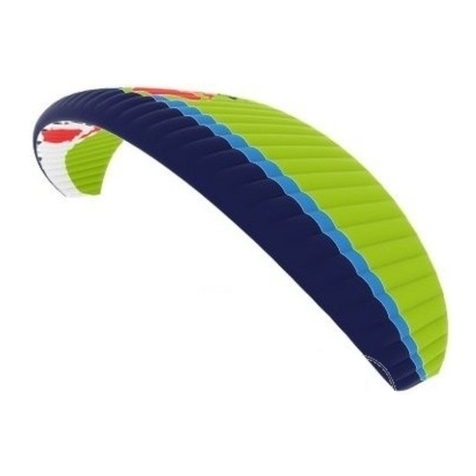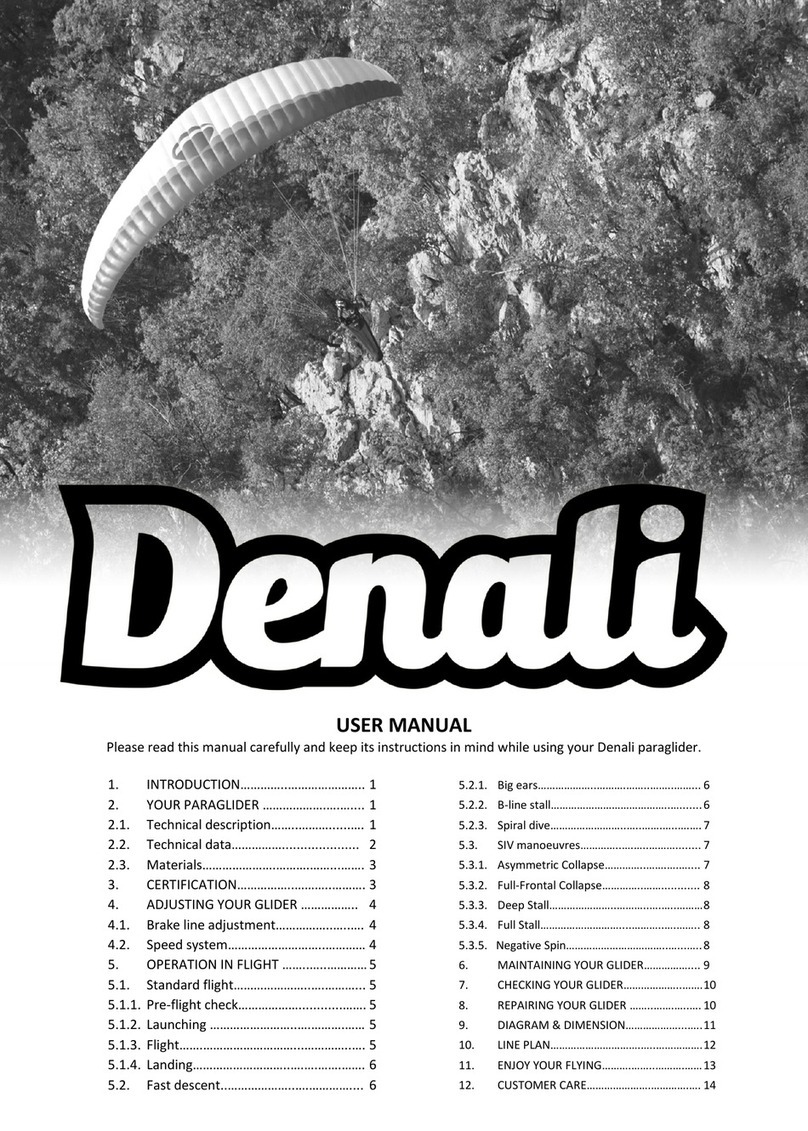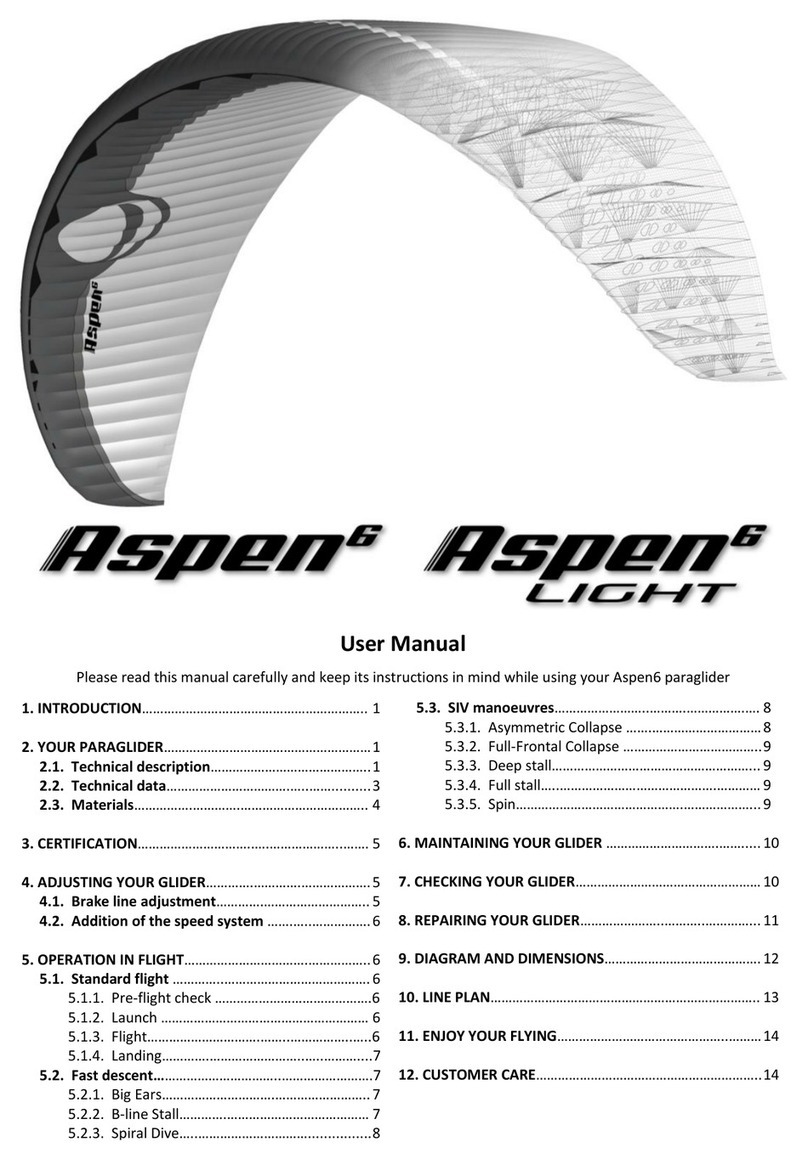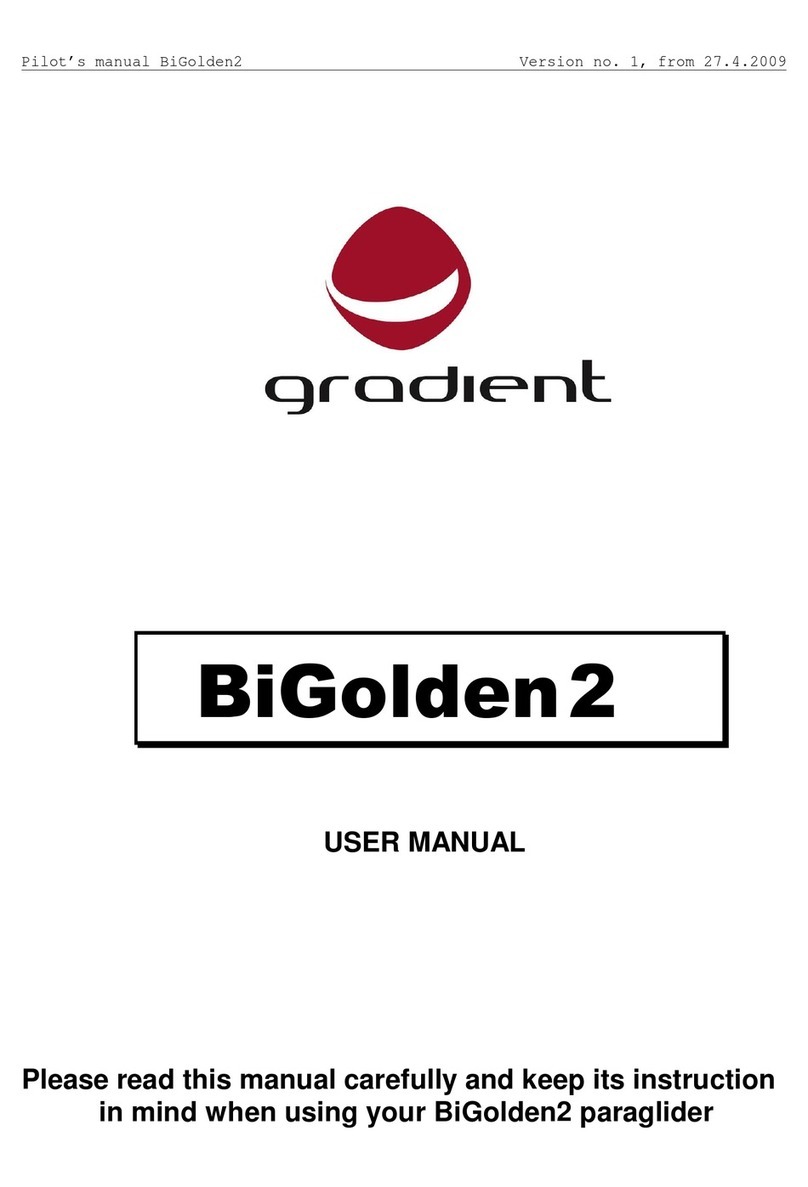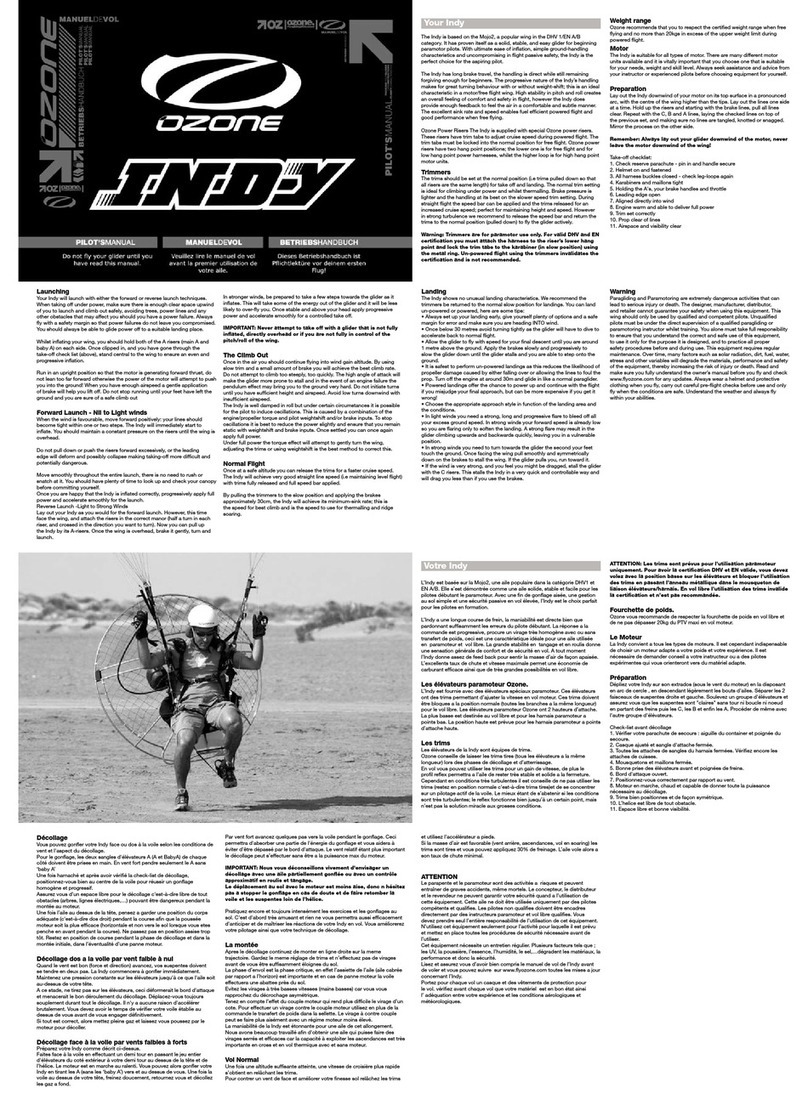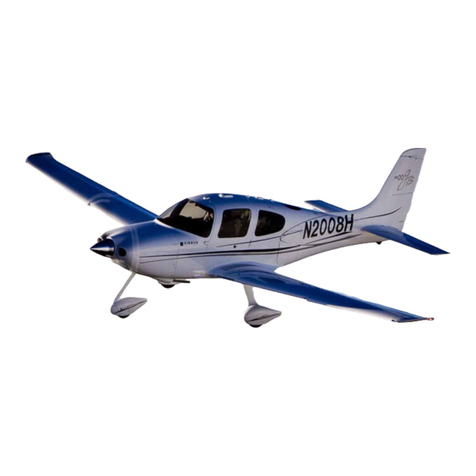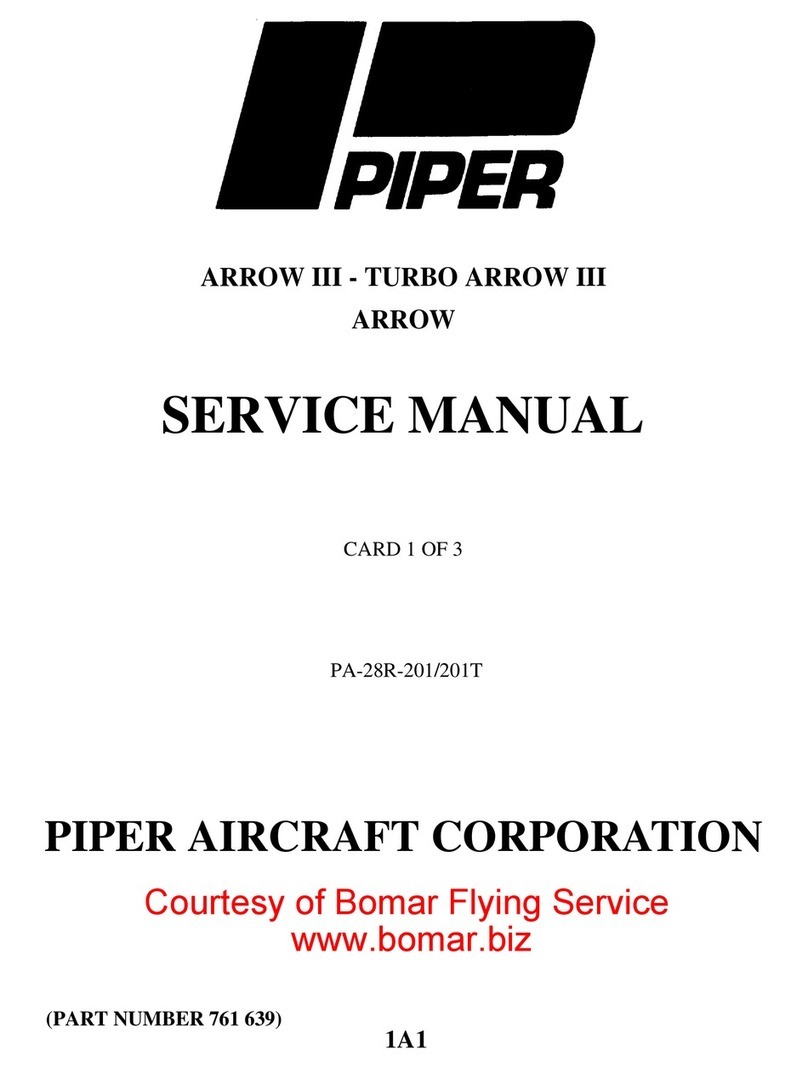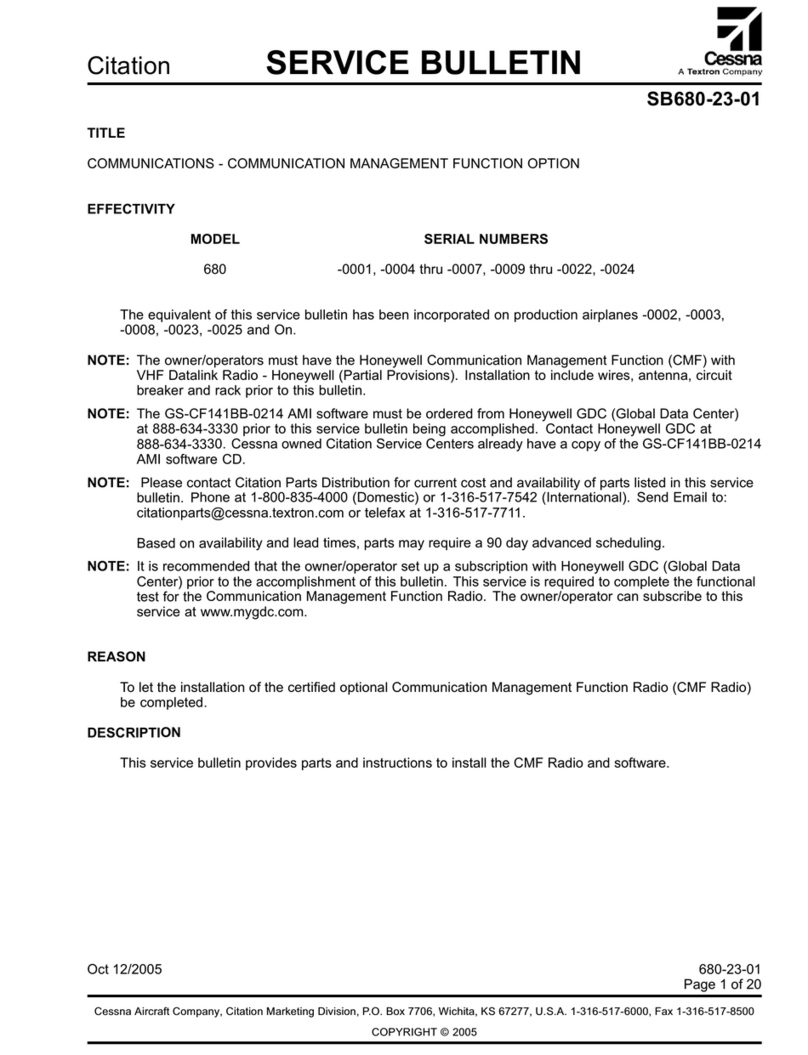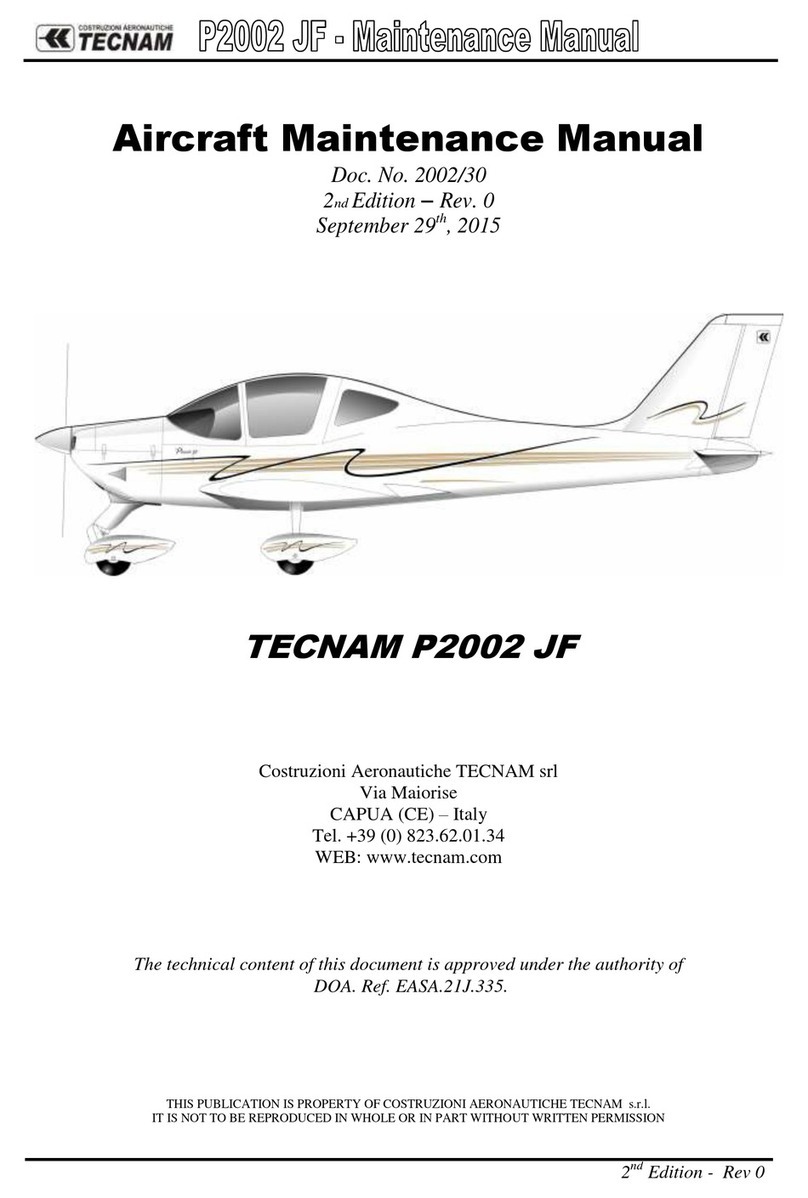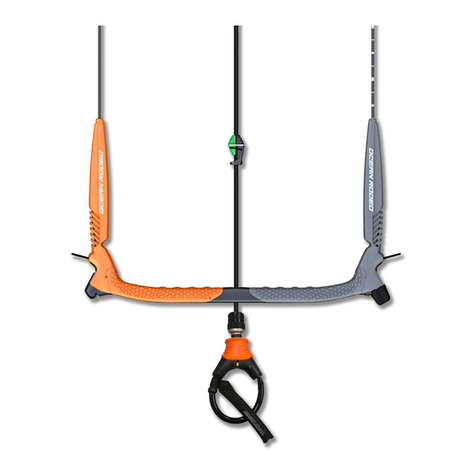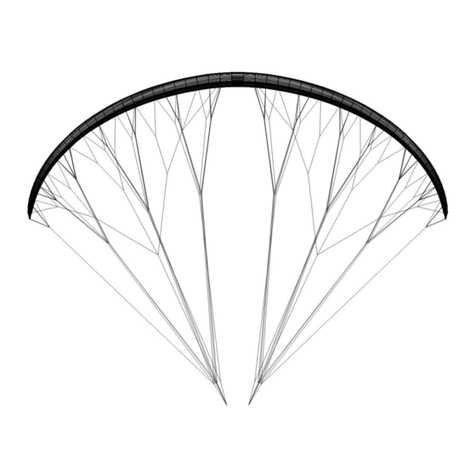Gradient Golden4 User manual

[en] - User manual, [de] - Betriebshandbuch, [fr] - Manuel d’ulisaon, [cz] - Uživatelská příručka

Gradient s.r.o., Plzenska 221/130, 150 00 Praha 5, tel+fax +420257216319, www.gradient.cx, gradient@gradient.cx.
User manual
[en]
Contents
1. Introducon......................................................1
2. Your paraglider..................................................1
2.1. Technical descripon.....................................1
2.2. Technical data...............................................2
2.3. Materials........................................................3
3. Cercaon......................................................4
4. Adjusng your glider........................................4
4.1. Brake-line lengths..........................................4
4.2. Addion of speed system............................4
5. Operaon in ight............................................5
5.1. Standard ight regime...................................5
5.1.1. Pre-ight inspecon...................................5
5.1.2. Launch.........................................................5
5.1.3. Flight...........................................................6
5.1.4. Landing........................................................6
5.2. Fast descent...................................................6
5.2.1. Big ears.......................................................6
5.2.2. B-line stall...................................................6
5.2.3. Spiral dive...................................................7
5.3. SIV manoeuvres............................................7
5.3.1. Asymmetric collapse..................................7
5.3.2. Full-frontal collapse..................................8
5.3.3. Deep stall..................................................8
5.3.4. Full stall......................................................8
5.3.5. Negave spin...........................................8
6. Maintaining your glider.................................8
7. Repairing your glider.....................................9
8. Checking your glider.....................................10
9. Enjoy your ying..........................................10
10. Line plan.......................................................11
Please read this manual carefully and keep its instrucon in mind when
using your Golden4 paraglider

1.
1. Introducon
Congratulaons on buying your new GRADIENT Golden4!
The new Golden4 is the latest wing from the Gradient development team. The wing is the
follow-up to the most successful Gradient model ever, the Golden series. The result is pure
style, an aerodynamic design with an incomparable variety of uses and the potenal to meet
the demands of all kinds of pilots.
The agility, li, performance and speed of the Golden4 are backed up by strong
passive safety. Gradient’s typical sensive handling and immediate feedback means
pilots relax and quickly start to y in harmony with the wing. It makes the Golden4
a truly reliable partner. Flying becomes intuive, leaving your mind free to concentrate on
making decisions about your ight.
Flying the Golden4 starts with the typical, easy take-o characteriscs Gradient pilots all over
the world appreciate. In the air, the Golden4 thermals at, even when ying small circles.
The wing reacts immediately to weight shiing and has precise brakes. Well-balanced wing
dynamics and a dened stall point give this intermediate glider typical Gradient handling.
The glider also behaves in a calm and predictable way in extreme situaons, leaving you
condent of your safety while you regain normal ight – no maer if it was you or turbulence
that caused the trouble.
The Golden4 is another high-end product, the result of Gradient’s successful design
philosophy that in the air, progress means simplicity. Finding elegant soluons to creang
that simplicity is the art of building a Gradient wing.
We believe that you will love your new glider’s ight characteriscs and construcon.
This manual provides informaon which will help you y safely and keep your wing in good
condion. If, aer reading this booklet, you have any further quesons or uncertaines,
please do not hesitate to contact Gradient directly or any authorised Gradient dealer and we
will gladly answer all your quesons.
When you have become familiar with your Golden4 we would welcome any feedback that
you might have about your new paraglider.
2. Your paraglider
2.1. Technical descripon
Gradient’s well-proved DDsystem, as used on the Aspen4 and Nevada gliders, have made
it possible to develop an intermediate glider without compromises in stability, behaviour
or performance for its class. The result is a light glider with aerodynamic improvements in
safety and performance too.
The Golden4 has three main line levels, a system Gradient has uses for years.
Careful selecon of lines and materials means the wing-loading is opmised in ight in
any situaon. Progressive line diameters along the span and chord are already standard in
Gradient wings and this combined with a self-trimming system and dierent line materials
mean the glider keeps its long-term geometry.
The main C-lines are connected to the karabiners through loops, allowing for easier
adjustment when your glider is serviced.
The Golden4 is cered to be own with a foot-operated speed system. The standard
speed system comprises two pulleys for each side with a working range of 14 cm
(size 28).
Meanwhile, opmal cell opening sizes and posion ensure ecient air intake at a very wide
angle of aack.

Gradient s.r.o., Plzenska 221/130, 150 00 Praha 5, tel+fax +420257216319, www.gradient.cx, gradient@gradient.cx.
The Golden4 is the rst Gradient glider where we have used Everlast, a double-coated
Porcher material. Everlast was developed by Gradient in co-operaon with Porcher Sport,
and this exclusive material provides gliders with long-term stability and durability.
Inside, the inner working of the prole is a result of Gradient’s sports class glider development.
Using the latest soware means the tension of the prole could be increased without
compromise. These improvements have allowed the Gradient team to tune the whole wing
without compromising safety.
Small, simple details make this glider complete. Gradient has paid aenon to details too,
including: new low-drag micro aachment points on the wing ps; clearing holes on the wing
ps; split A-risers with special karabiners; and a new rucksack, inner bag and riser bag.
Length of the Golden4 risers (mm):
Size 22 A1,A2 B C
non-accelerated 440 440 440
accelerated 320 340 440
Size 24 A1,A2 B C
non-accelerated 460 460 460
accelerated 330 353 460
Size 26 A1,A2 B C
non-accelerated 480 480 480
accelerated 345 370 480
Size 28 + 30 A1,A2 B C
non-accelerated 500 500 500
accelerated 360 385 500
2.2. Technical data
Golden4 22 24 26 28 30
Flat area m2 22.42 24.40 26.57 28.95 31.30
Projected area m2 19.31 21.02 22.89 24.94 26.98
Span m10.89 11.35 11.86 12.38 12.88
Projected span m8.96 9.35 9.75 10.18 10.59
Aspect rao 5.3 5.3 5.3 5.3 5.3
Projected aspect rao 4.16 4.16 4.16 4.16 4.16
Max. chord m2.58 2.69 2.81 2.93 3.05
Min. chord m 0.62 0.64 0.67 0.70 0.73
Number of cells 51 51 51 51 51
Line consumpon m230.7 240.7 251.2 262.2 272.7
Weight of the glider kg 4.3 4.9 5.2 5.6 5.9
Min. take-o weight kg 62 75 85 95 110
Max. take-o weight kg 77 90 100 115 130
Cercaon EN / LTF BBBBB
* Take-o weight is the weight of the pilot plus equipment and paraglider (18 kg to 25 kg)
2.
A1
A2
B
C

3.
2.3. Materials
Canopy Fabric Finish Weight
Upper sail-leading edge Skytex 40 Everlast 40 g/m2
Upper sail-rear part Skytex 38 Universal 38 g/m2
Boom sail Skytex 38 Universal 38 g/m2
Ribs Skytex 40 Hard 40 g/m2
Non-carrying ribs Skytex 40 / Skytex 32 Hard / Hard 40 g/m2 / 32 g/m2
Diagonals Skytex 40 / Skytex 32 Hard / Hard 40 g/m2 / 32 g/m2
Reinforcements Scrimm F02 420 X15A 180 g/m2
Reinforcements 060981450YET001 Scky laminate 60 g/m2
Reinforcements Hahl Nylon 6, 2/1200 Ø 2 mm
Lines Finish Diameter Strength Material
Liros DC 060 uncovered Ø 0.6 mm 60 daN Dyneema
Liros DC 100 uncovered Ø 0.7 mm 100 daN Dyneema
Liros DC 120 uncovered Ø 0.8 mm 120 daN Dyneema
Cousin Vectran 12100 uncovered Ø 0.6 mm 60 daN Vectran
Edelrid 7850-080 covered Ø 1.0 mm 80 daN Dyneema/PES
Edelrid 7850-100 covered Ø 1.1 mm 100 daN Dyneema/PES
Edelrid 7850-130 covered Ø 1.3 mm 130 daN Dyneema/PES
Edelrid 7343-140 covered Ø 1.3 mm 140 daN Aramid/PES
Edelrid 7343-190 covered Ø 1.5 mm 190 daN Aramid/PES
Edelrid 7343-240 covered Ø 1.8 mm 240 daN Aramid/PES
Edelrid 7343-280 covered Ø 2.0 mm 280 daN Aramid/PES
Risers Fabric code Width Strength Material
Webbing 15 mm 850 daN PAD
Webbing 22 mm 1250 daN PAD
Pulleys Paray Al
Pulleys Rilay PAD
Karabiners Maillon Rapide Ø 3.5 mm 750 daN Steel
3. Cercaon
All sizes of the Golden4 are cered EN B and LTF B.
The cercaon cercate on your Golden4 is found on a rib in the middle of the canopy.
Cercaon is valid for ABS type harnesses. This type of harness allows a certain degree
of adjustment to be made to the length of the chest strap. The recommended distance
between the karabiners is 46 cm to 49 cm.
In common with all other paragliders, when looser cross-bracing is used while ying the
Golden4, the pilot’s weight-shi control is greater. The glider is also more sensive to
movement in the surrounding air. When cross-bracing is ghter, the pilot feels subjecvely
more stable, but turning by weight-shi is praccally ineectual.

Gradient s.r.o., Plzenska 221/130, 150 00 Praha 5, tel+fax +420257216319, www.gradient.cx, gradient@gradient.cx.
4.
WARNING: The Golden4 paraglider is only built for hill or tow launching. It is not built to
withstand jumping from a plane, balloon, building or for any jumps where there is a belated
opening of the canopy.
4. Adjusng your glider
Before it reaches the customer every Golden4 goes through a nal check and test-ight
to verify that its characteriscs and measurements correspond to the manufacturer’s
specicaons. You may only make adjustments to brake-line lengths or to the speed system
of your Golden4 – and only then in keeping with the recommendaons of this manual.
Other adjustments or changes to your Golden4 lead to a loss of guarantee, airworthiness and
validity of the Cercaon. Amateur modicaon may endanger yourself and other pilots.
If you do have any suggesons for improvements let us know and our test-pilots will try out
your ideas without risk to yourself.
4.1. Brake-line adjustment
When you receive your new Golden4 the brake-line length is adjusted to be the
same as that used during the ight tests. This length should suit most pilots and is
indicated on the main control line. It is of course possible to adjust the brake-line
length to suit each pilot’s physical build, height of harness hang points, or style of ying.
We recommend that you act wisely when adjusng brake-line length and change the length
in small, successive steps.
If you need to adjust brakes back to the basic posion and the marks on the main brake lines
are vague, use the following lengths:
Golden4 22 24 26 28 30
Main brake line 220 cm 230 cm 239 cm 249 cm 259 cm
Brake lines that are too short may:
1) lead to fague from ying with your hands in an unnatural posion
2) impede recovery from certain unstable manoeuvres
3) will certainly reduce your glider’s speed range.
Brakes that are too long will:
a) hamper pilot control during launch
b) reduce control in extreme ying situaons
c) make it dicult to execute a good are when landing.
Each brake line should be ed securely to its control handle. Use knots which will guarantee
this, for example, a Double Dragon.
4.2. Addion of speed system
The Golden4 is equipped with a very eecve foot-operated speed system as standard.
Pressure on the foot srrup shortens the A and B risers and reduces the angle of aack of
the canopy. Thanks to the relave lengths of lines C and D, near the trailing edge, the prole
is inclined in a way that preserves the aerodynamic characteriscs of the wing. The working
range of the speed system pulleys is 14 cm. Make sure you can use the whole of this range
when you aach your speed srrup.
5. Operaon in ight
This manual is intended as a guide to the characterisc features of your new Golden4
paraglider. Under no circumstances should it be used as a “learn-to-y” manual for
paragliding or as a substute for a training course.

5.
5.1 Standard ight
5.1.1 Pre-ight check
A thorough pre-ight check is essenal for safe ying – pay special aenon to it. Above all,
you should check that the canopy, lines and risers are free from damage and tangles. Also
don’t forget to check your harness and your reserve parachute.
Before launch spread the canopy out in a slight arc and check that:
all cell openings are free
no lines are looped around or under the canopy
no lines are tangled or have a knot in them
any twigs, grass or other objects are not tangled in the lines or the canopy
risers are not twisted
control lines run freely through the pulleys
knots on control handles are secure
all karabiners (Maillons) on risers are ghtened
5.1.2 Launch
Launching the Golden4 is straighorward, either by forward (Alpine) launch or by reverse
launch. A dynamic pull on the front risers (A, coloured red) will bring the canopy simply and
easily above the pilot’s head. The canopy inates from the centre equally and smoothly. The
Golden4 has no tendency to outrun the pilot and quickly stabilises above the pilot. Once
there, visually check the canopy and the lines before taking o. Take o can be made easier
by a light pull on the brakes.
5.1.3 Flight
The Golden4 is trimmed to y at best glide when the brakes are fully up. Best sink rate is
achieved when both brakes are drawn down evenly to about 20-25% of their range.
Turbulent condions
When ying through severe turbulence stabilise the canopy by simultaneously applying a lile
brake to both sides. Flying with a lile brake applied will also help to prevent deaons and give
you more feedback about what the air is doing and how the glider is reacng. Responding correctly
to the paraglider’s movement by means of the brakes and weight shi is known as “acve ying”.
A pilot demonstrang good acve-ying skills will signicantly reduce both the number and
severity of collapses he or she experiences.
Turning
The Golden4 is very comfortable and pleasant in turns. Handling characteriscs are responsive
and accurate and demand no special habits or non-standard procedures. When developing
the Golden4 special aenon was devoted to the brake pressure. The result is that brake
travel and pressure have been opmised. Brake pressure is reassuringly progressive. In ight,
brakes are rm but responsive and precise and allow for perfect communicaon with the
canopy. You will nd that a harness with fairly loose cross-bracing will help the glider turn.
In an emergency (eg a broken brake line) the glider can be steered with the rear risers or by
weight shi.
Using the speed system
Maximum speed is one of the strong points of Gradient paragliders and the Golden4 is no
excepon. Not only has the glider got a very high maximum speed, but unlike some other
paragliders the full speed range is useable. In spite of this exceponal stability at high
speed don’t forget that any collapse at full speed will be more severe than the same event
experienced at normal trim speed. Always keep both hands on the controls when ying fast
in turbulence and be ready to release the speed system immediately at the rst sign of a
collapse. Use the speed system very carefully or not at all at low altude.

Gradient s.r.o., Plzenska 221/130, 150 00 Praha 5, tel+fax +420257216319, www.gradient.cx, gradient@gradient.cx.
6.
5.1.4 Landing
Landing the Golden4 is very simple and should oer no diculty. On your rst ights you may
be surprised at how well it glides. Take account of this when making your landing approach!
Into wind, at about one metre above the ground pull the brakes down all the way. In nil-wind
condions, or if forced to make an emergency landing downwind, you may prefer to take a
wrap of each control line to enable a more dynamic are.
5.2. Rapid descent
Sooner or later every pilot will need to descend quickly. It might be because of a sudden and
unexpected change in the weather, reaching cloud base and not wishing to enter cloud, or
simply because you need to nish your ight quickly. Addionally, if where you are landing
is thermic, it is oen very dicult to land without using a rapid descent method. There are
three main methods for achieving a rapid descent and they are: Big Ears, B-Line Stall and
Spiral Dive.
Pracse these manoeuvres under the supervision of an instructor and with a reserve
parachute. Never compromise your safety.
5.2.1 Big Ears
This is the easiest technique for a rapid descent. Depending on how much of the wing p you
deate, 3 m/s to 6 m/s sink rate can be achieved. While in Big Ears your sink rate and forward
speed can be further increased by using the speed system. The Golden4 can be steered while
Big Ears are in by means of weight shi.
Iniaon: Take hold of the outer A-lines on both sides as high as possible and pull them down
smoothly. Hold them rmly. The eecve area of the glider is reduced equally on both sides
of the wing. The size of the deated area depends on how deeply the lines are pulled down
(or on the number of lines pulled – one or two outer lines on both sides). Be sure to pull both
sides equally.
Recovery: Under normal circumstances the Golden4 will open automacally when the
A-lines are released. Opening may be accelerated by gently pumping the brakes (repeated
symmetrical braking on both sides).
5.2.2 B-Line Stall
This is a very eecve rapid descent technique. Depending on how far the B-risers are pulled
down, the sink rate is between 5 m/s and 8 m/s.
Iniaon: Take hold of the B-risers at the top and smoothly pull them down unl the canopy
shows a span-wise crease where the B-lines aach to the canopy. Your sink rate will increase
considerably while your forward speed will decrease to praccally zero. Don’t be startled
when the airow over the top surface is disrupted and the paraglider enters a parachutal
stall without moving forward. It will soon stabilise above your head.
Recovery: On releasing the B-risers the Golden4 automacally returns to normal ight
without staying in deep stall or surging in front of the pilot. Let go of the risers smoothly and
symmetrically.
CAUTION: Do everything symmetrically and at the same me. If the B-risers are released
unevenly the canopy can enter a turn. If the risers are released slowly and very unevenly you
could enter a spin.
5.2.3 Spiral Dive
The Spiral Dive is the most eecve way of making a fast descent. Every pilot should be able
to perform a spiral dive and one day you may need to. When in a Spiral Dive always stay
aware of your altude, which decreases very rapidly. The sink rate reached in a Spiral Dive
can be more than 15 m/s. During the manoeuvre the pilot and glider will experience strong

7.
centrifugal forces. Forces of greater than 3G are possible – a great strain on the pilot as well
as the glider.
Iniaon: Smoothly pull on one brake so that the glider goes from a normal 360-degree turn
into a steep turn and from there into a spiral dive. The transion into a spiral dive can be
made easier by weight shiing to the inner side of the turn. Keep an eye on the tension of
the brakes all the me: reduced tension signals an overload of the glider and danger of falling
into a negave spin.
Recovery: The Golden4 recovers from a Spiral Dive automacally as soon as the brakes are
released. Release them smoothly and always nish a Spiral Dive with safe altude!
CAUTION: When exing the Spiral Dive make sure your posion in the harness is neutral.
Recovery from a Spiral Dive can be delayed if you are weight shiing to the inner side of the
turn.
5.3 SIV manoeuvres
No maer what category of canopy you y or what level of cercaon it has, in
turbulence or in strong thermals you may experience all kinds of collapses. The
Golden4 behaves comfortably in these situaons. Indeed, not only does the glider
deal with extreme ight situaons automacally, but it also oers an above-average
degree of safety. Even so, you must follow all safety rules when pracsing SIV.
Always pay aenon to your altude.
Before performing any SIV manoeuvre remember:
Pracse throwing your reserve on the ground, in a simulator, so that reserve deployment is
ecient and automac.
Rapid altude loss and considerable rotaonal forces may develop during unstable
manoeuvres. Take account of these factors when throwing your reserve.
5.3.1. Asymmetric Collapse – one side of the canopy collapses
Iniaon: Take hold of the outer A-lines (outer A-riser) on one side and pull them down
smoothly. The wing p will collapse to form a characterisc Big Ear. The size of the ear
depends on the depth to which the lines are pulled as well as the number of lines pulled
down. You can stop any turn tendency by applying the opposite brake and by weight shiing
onto the inated side of the canopy.
Recovery: Under normal condions the Golden4 will re-inate spontaneously when the
pulled lines are released. Inaon me and loss of altude can be reduced by suitable pilong.
To stop any tendency to turn o course pull the brake on the inated side (be careful not to
overreact and stall the inated side) and weight shi to that side. If the collapse remains then
re-inate the collapsed side by “pumping” the brake on the collapsed side.
5.3.2. Full Frontal Collapse
Iniaon: Take hold of both A-risers at the top and pull them down unl the leading edge
collapses.
Recovery: In normal condions the Golden4 will recover normal ight automacally as soon
as the front risers are released. Applying the brakes on both sides simultaneously can help
re-open the paraglider
5.3.3. Deep Stall
Iniaon: Pull both brakes smoothly unl the sink rate increases markedly and the forward
speed reaches almost zero. The pull on the brakes should be controlled so that the canopy
stays inated and doesn’t fall back into a full stall.

Gradient s.r.o., Plzenska 221/130, 150 00 Praha 5, tel+fax +420257216319, www.gradient.cx, gradient@gradient.cx.
8.
Recovery: The Golden4 cannot stay in deep stall ight, so aer the brakes are released the
glider automacally returns to normal ight. If you need to, you can accelerate recovery by
pulling hard on both brakes, followed by a fast release. Or you can pull lightly on the A-risers.
CAUTION: If you pull too hard on the A-risers you may experience a full frontal collapse.
5.3.4 Full Stall
Iniaon: Wind the control lines once or twice around your hands and pull both of them
down smoothly. Hold them down unl the canopy falls behind the pilot and deforms into a
characterisc crescent shape. Hold your hands rmly (press them underneath the seat) and
be careful that you do not release the brakes prematurely or asymmetrically.
Recovery: The Golden4 recovers from a full stall automacally aer the brakes are smoothly
released. During correct recovery from a full stall the Golden4 shows no extreme tendencies
such as a diving in front of the pilot. If the brakes are released prematurely or too quickly
there is a possible tendency for the glider to dive ahead of the pilot. This can be corrected by
adequate simultaneous braking on both-sides.
CAUTION: When exing a Full Stall if the brakes are released asymmetrically the glider may
suer a massive asymmetrical collapse followed by a tendency to enter a spin.
5.3.5 Negave Spin
Iniaon: Slow down by braking to nearly minimum speed. Then pull a brake on one side
all the way down while simultaneously releasing the brake on the other side. Because the
stalled side falls back, the canopy suers airow disrupon over one half of the wing which
results in a spin and a rapid loss of altude.
Recovery: Under normal circumstances the Golden4 is capable of recovering from
a Negave Spin automacally when the brakes are released.
CAUTION: In general when there is a very fast or a long-lasng rotaon and when the brakes
are released too quickly, the canopy may shoot in front of the pilot followed by a massive
asymmetrical collapse.
WARNING: Whenever a paraglider is not in normal ight and airow is disrupted there is
always a rapid increase in sink rate and therefore a substanal loss of altude.
REMEMBER: When pracsing SIV the wrong manoeuvre at the wrong me may change a
fairly easy situaon into a dangerous problem. You are also exposing your glider to forces
that may damage it. Pracse SIV manoeuvres only under the supervision of an instructor and
with a reserve parachute.
6. Maintaining your glider
If you handle your glider with care and store it in a suitable place it can last you a very long
me. On the other hand, neglecng maintenance, bad storage and the use of unsuitable
cleaning products can reduce the lifespan of your glider signicantly or may even make it
dangerous.
You must keep to these rules:
Choose a suitable area for your launches. Lines caught on roots or rocks lead to unnecessary
strain on the aachment tabs during inaon. Snagging lines may rip the canopy ssue or
damage lines.
When landing, never let the canopy fall on its leading edge in front of the pilot. The eect
of these forceful collisions and the sudden pressure increase can severely damage the air-
resistant coang of the canopy as well as weaken the ribs and seams.

9.
Protect the canopy from unnecessary strain. Inconsiderate handling of your glider – pulling
it over grass, soil, sand or rocks – will signicantly reduce its lifeme and increase its air-
porosity.
When preparing the paraglider for a launch or when ground handling, be sure not to step on
any of the lines or the canopy.
Don’t e any unnecessary knots in the lines. Packing methods where special knots are made
in the lines as used on parachutes and reserve parachutes are not suitable for packing the
lines used on paragliders.
Protect your canopy and lines from unnecessary exposure to sunlight. UV-rays can damage
many parts of a paraglider.
Try not to pack your glider when wet. If it’s unavoidable then dry it as soon as possible but
away from direct sunlight. Be careful to avoid storing your canopy wet – this is the most
common reason for cloth degradaon, and is easily preventable.
Don’t let your glider come into contact with seawater. If it does, rinse the lines, canopy and
risers with fresh water and dry before storing.
Aer ight or when storing always use the inner protecon sack.
When storing or during transport make sure your glider isn’t exposed to temperatures higher
than 50 degrees Celsius.
Never let the paraglider come into contact with chemicals. Clean the glider with clean
lukewarm water only.
For long-term storage don’t pack the glider too ghtly. Store it in a cold, dry and well-
venlated room.
Aer tree- or water-landings always examine the glider carefully. If you suspect that the
ight features of your paraglider have changed, contact an authorised Gradient supplier as
soon as possible.
7. Checking your glider
Aer 200 ying hours or aer latest two years your Golden4 must be thoroughly checked
and tested by the manufacturer or by Gradient authorised service centre.
This check is primarily focused on:
- measuring of porosity
- measuring of tear strength of fabric
- sewing of panels, aachment points, cell openings, etc.
- condion of lines and risers
- strength of lines
- geometry of the suspension system
All data are recorded in the test report. On the basis of the real wing’s condion, the check
expert can dene the next check interval; under normal circumstances is it two years.
8. Repairing your glider
Only small repairs – ie repairs that don’t change the airworthiness of the paraglider – may
be done by the user. These include: xing small tears (but not seams) up to 10 cm; changing
damaged lines; and changing rubber line-xaon rings on the small karabiners.
When repairing your paraglider on your own follow these rules:
When repairing the sail use a self-adhesive patch specied for this purpose. Every Golden4
comes with a small amount of self-adhesive material which is enough for small repairs.

Gradient s.r.o., Plzenska 221/130, 150 00 Praha 5, tel+fax +420257216319, www.gradient.cx, gradient@gradient.cx.
The only admissible repairs done on lines are those where the damaged lines are changed for
new ones. Lines must be exclusively supplied by Gradient, an authorised dealer or authorised
service centre. When ordering new lines use the codes in the aached line diagram. Use the
code “G4” (Golden4) and tell us the size your glider followed by the line code. For example,
the outside long line in row A for a Golden4 28 is: ‘G4 28 A 1.3.’
An excepon to this is an emergency repair while out ying. For this purpose Gradient
encloses a spare line with every Golden4 with a prepared loop on one end. To get the right
length adjust it according to the same line on the opposite side of the canopy and then, if
necessary, aach your brake handle. As soon as you can, change the line for an original one
from your authorised Gradient service centre.
Aer changing any lines a thorough pre-ight check must be done. Don’t hesitate to ask your
instructor or an experienced colleague for help. If you’re not sure, entrust the job to either
the manufacturer or an authorised Gradient dealer.
9. Enjoy your ying
Even though the Golden4 has outstanding performance and stability it must be understood
that even the safest paraglider is an aircra and that all air sports can be relavely dangerous.
Remember that your safety lies in your own hands and that “lucky pilots are well prepared
pilots”.
Never underesmate weather condions. And never forget that you are ying for pleasure
and not to become a ‘fallen hero’. Remember this and the fun that only free-ying can bring
will be yours.
We believe that your sensible atude and the ight characteriscs of your Golden4 will
combine to ensure you have many hours of fantasc ying.
GRADIENT wishes you many fabulous ights and happy landings.
Ondřej Dupal Václav Sýkora
Director Designer
10.


Table of contents
Other Gradient Aircraft manuals
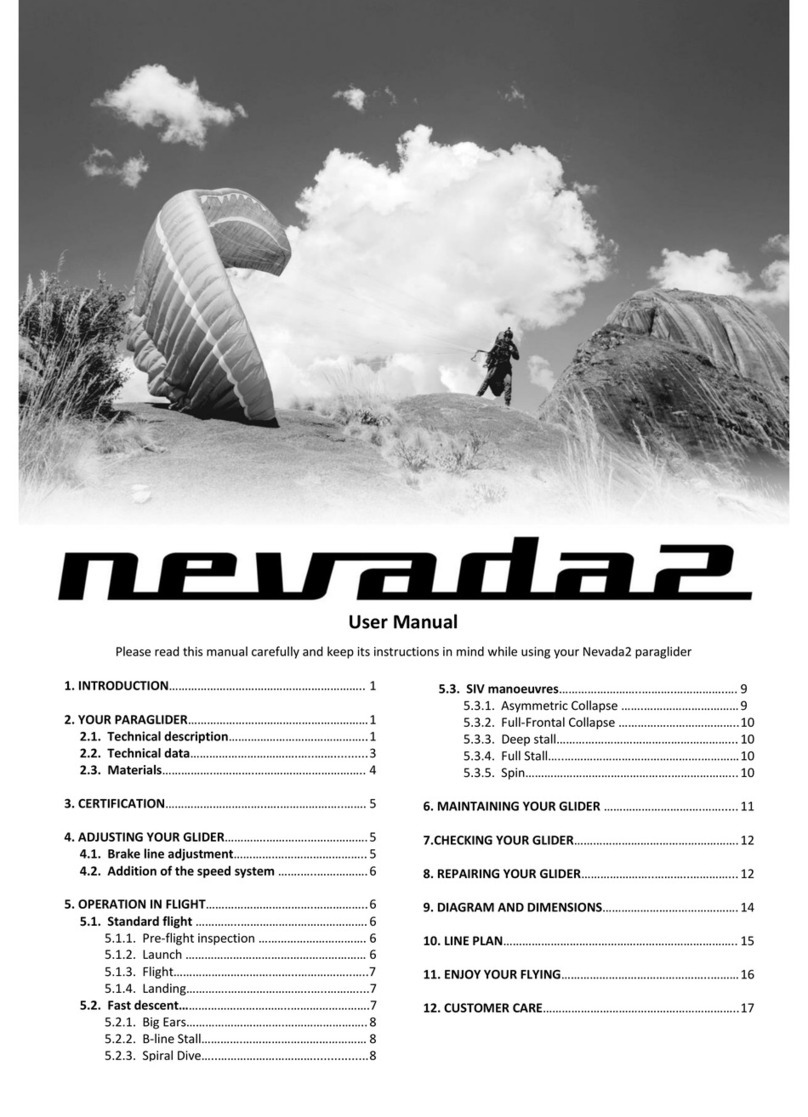
Gradient
Gradient Nevada2 User manual
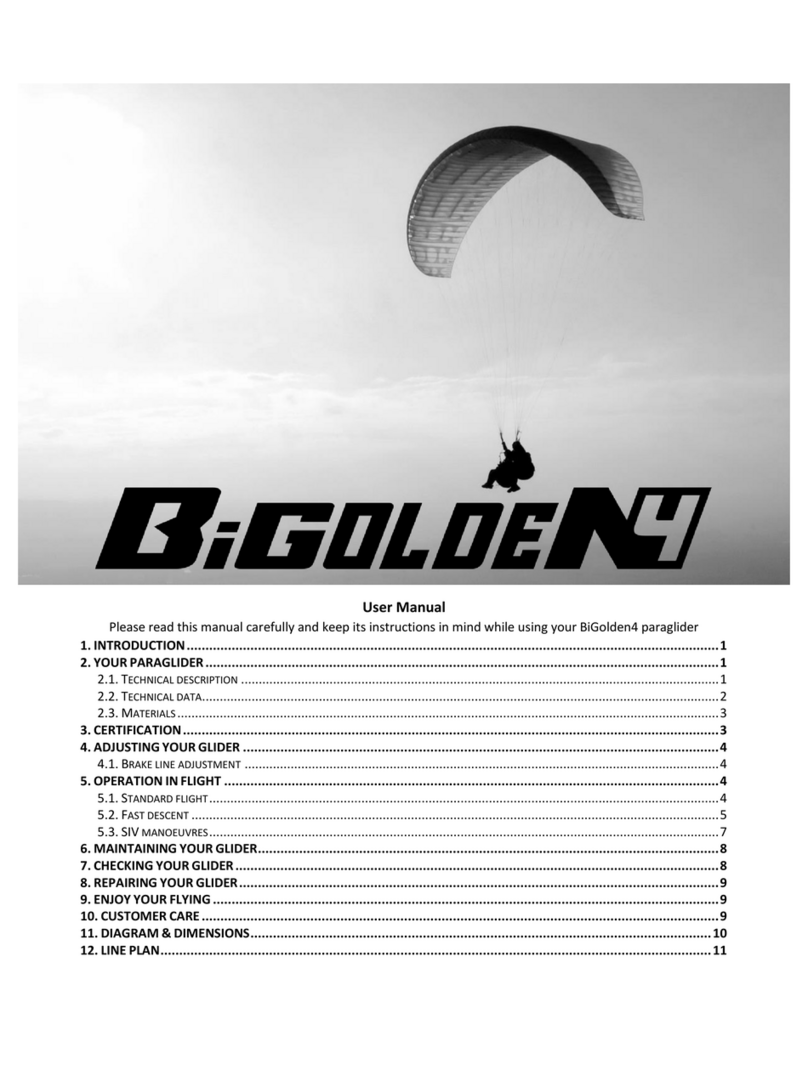
Gradient
Gradient BiGolden4 User manual

Gradient
Gradient FREESTYLE 2 User manual
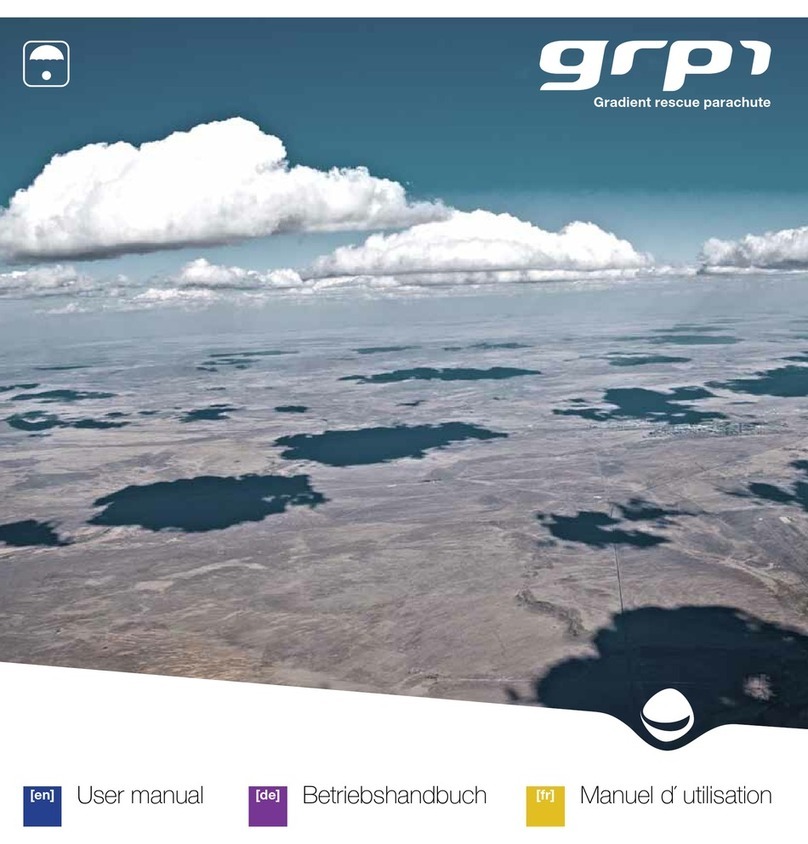
Gradient
Gradient GRP1 Installation and operation manual
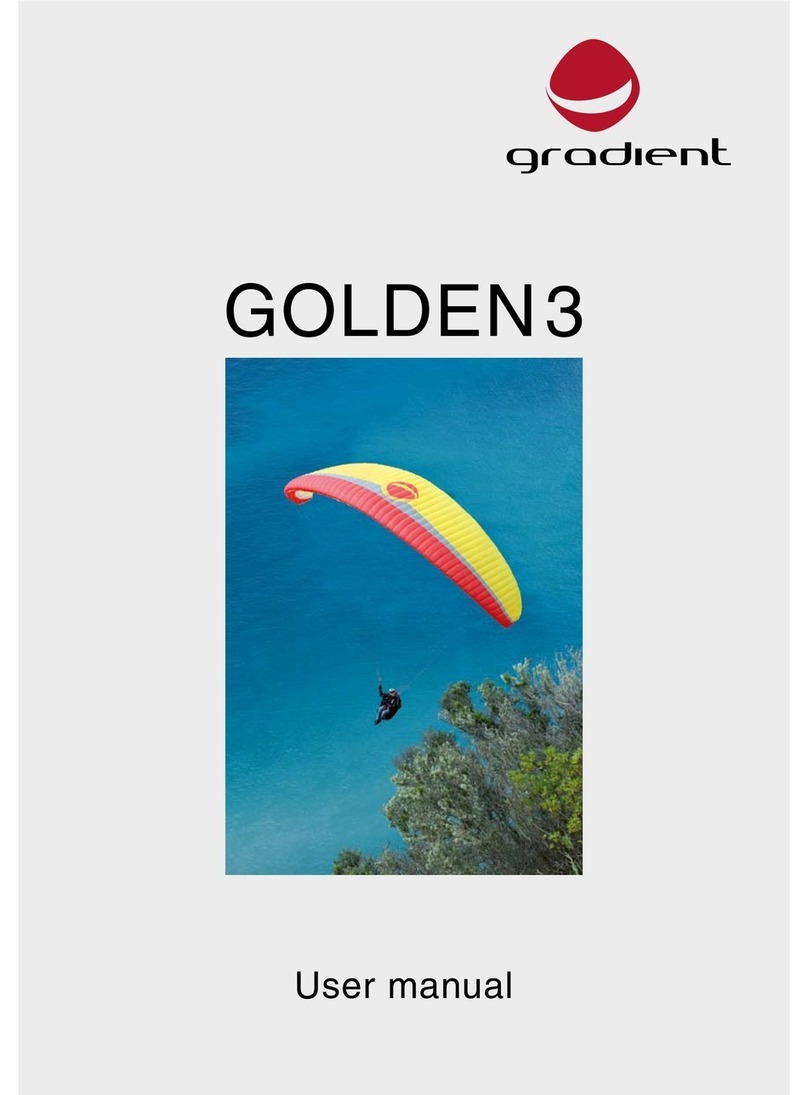
Gradient
Gradient GOLDEN3 User manual

Gradient
Gradient BRIGHT III User manual
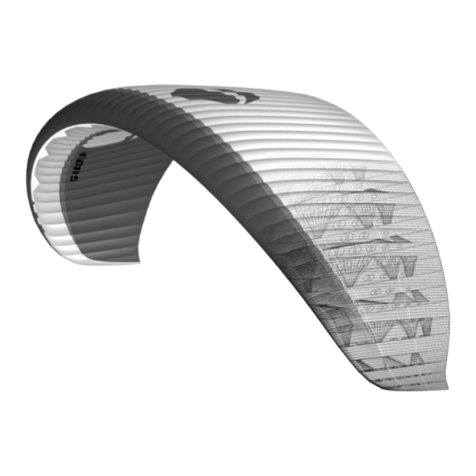
Gradient
Gradient Montana 3 User manual
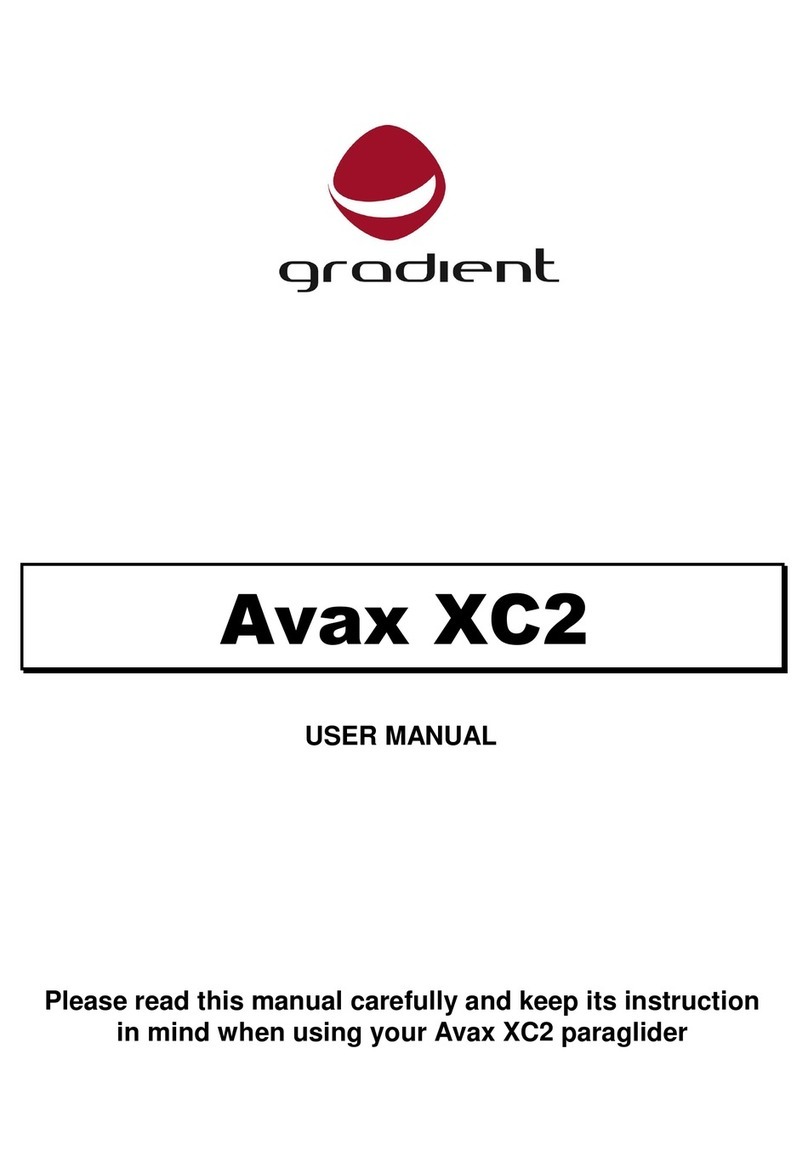
Gradient
Gradient Avax XC2 User manual
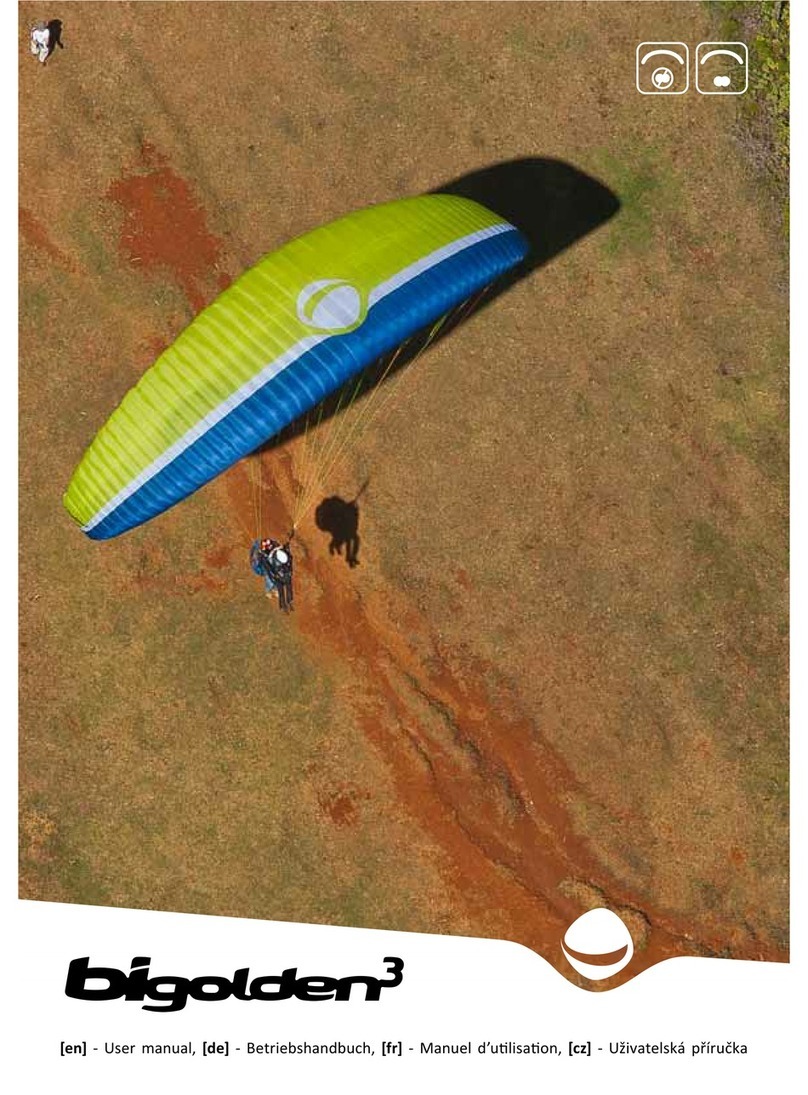
Gradient
Gradient bigoldern3 User manual
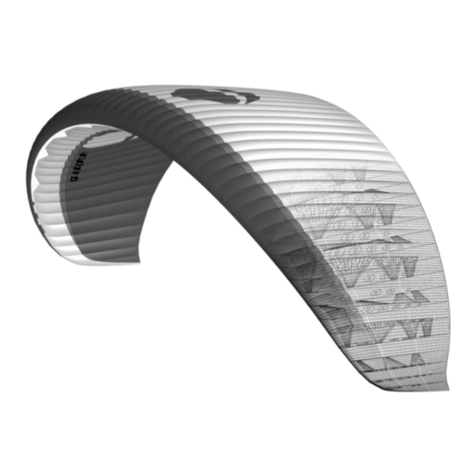
Gradient
Gradient Golden5 User manual
Popular Aircraft manuals by other brands

SC
SC Mystic-4 manual

Textron
Textron Cessna Citation Excel 5355 Operation manual
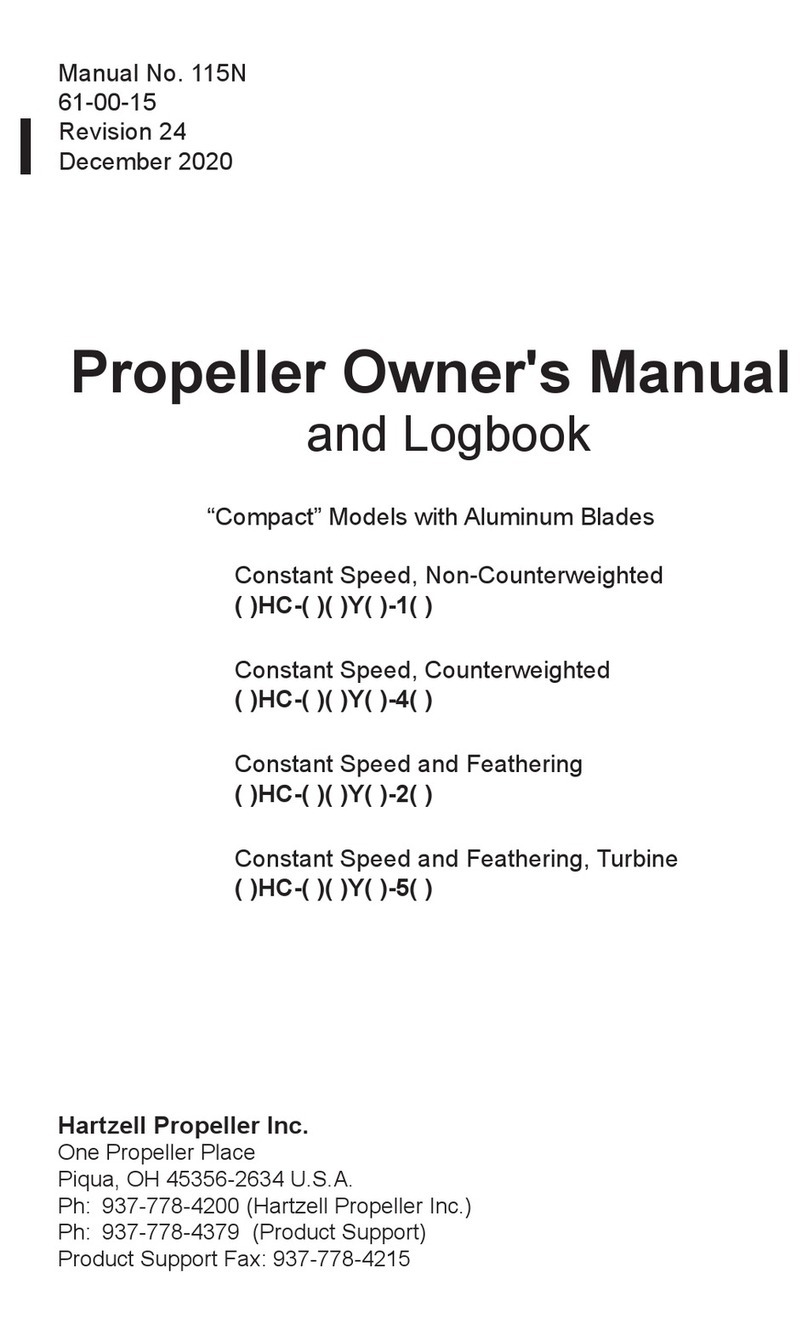
Hartzell
Hartzell HC-Y-1 Series Owner's Manual and Logbook
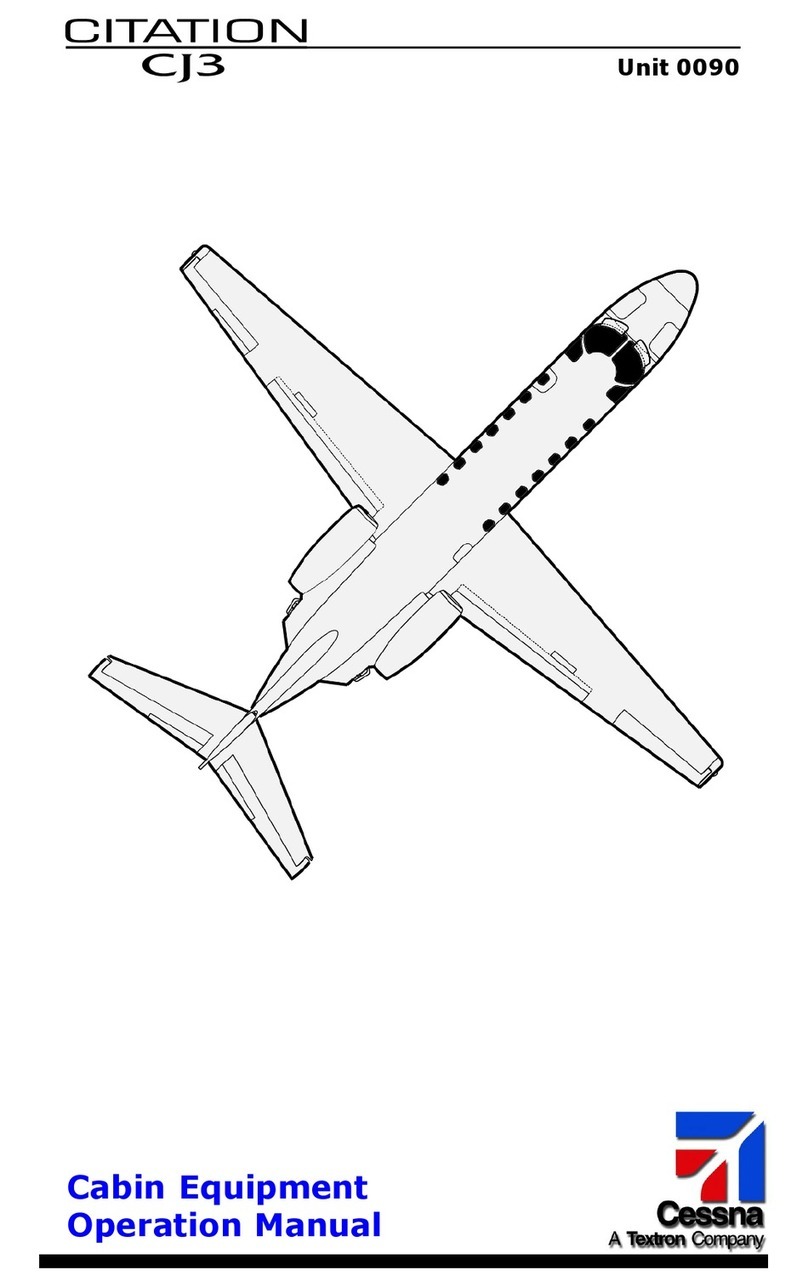
Textron
Textron Cessna Citation CJ3 Operation manual

DG Flugzeugbau
DG Flugzeugbau LS10-s Flight manual
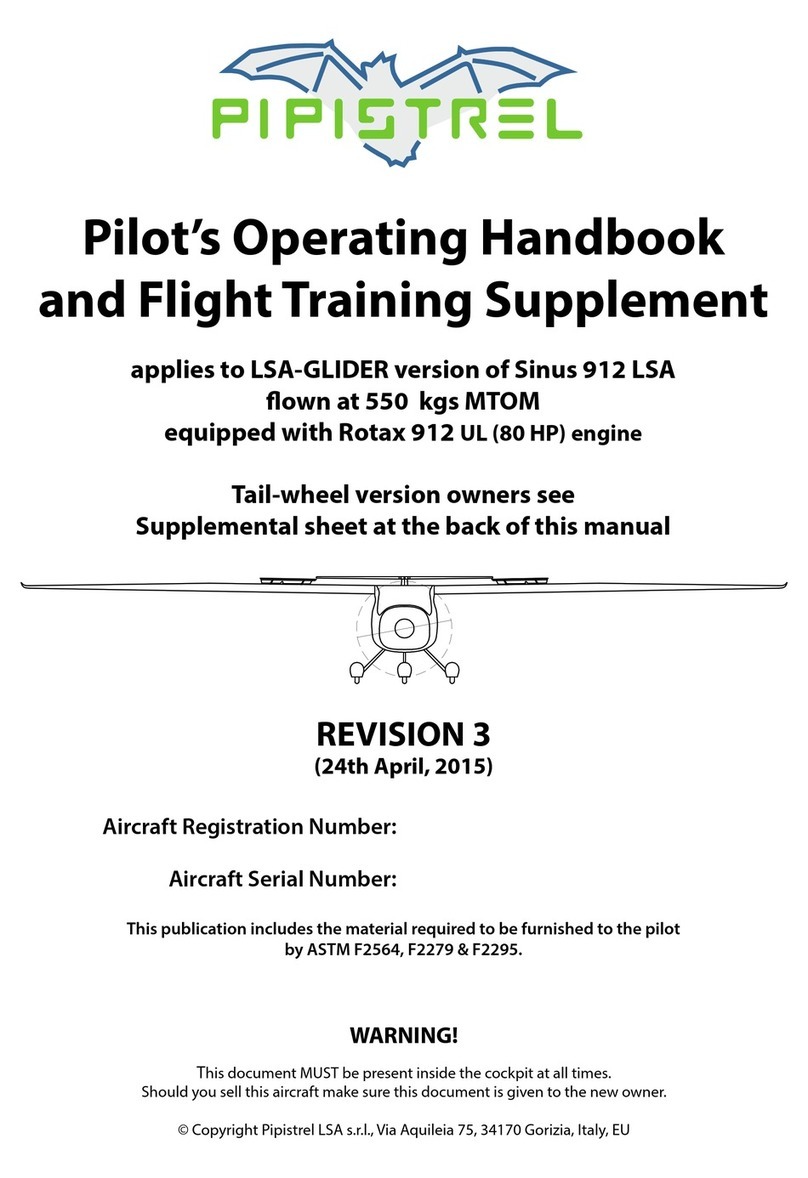
Pipistrel
Pipistrel Sinus 912 LSA LSA-GLIDER Pilot operating handbook
